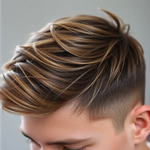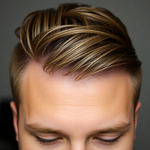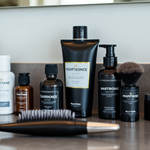
Semi-Permanent Hair Color: Low-Waste Hack to Expand Your Men's Capsule Wardrobe
09 September 2025
Share
Semi-Permanent Hair Color: A Low-Waste Shortcut to Better Style
Semi-Permanent Hair Color is one of the fastest, least-wasteful ways to change how your clothes read. Struggling to make a small capsule wardrobe look deliberate? A quick color refresh—think depth, tone correction, or a softened grey—can elevate the same five pieces into multiple complete outfits. This guide gives you practical, eco-aware steps to use hair color as a styling tool, not a cosmetic overhaul.
Why this works for a men's capsule wardrobe
- Visual cohesion: Hair tone affects contrast—get it right and a simple blazer, tee, and jeans combo suddenly feels curated.
- Fewer purchases: Instead of buying seasonal pieces, tweak your grooming to suit what you already own.
- Low commitment: Semi-permanent color fades over weeks, so you can experiment without long-term regret.
Semi-Permanent Hair Color: What it actually does
Semi-permanent formulas coat the hair shaft rather than penetrating the cortex. That means gentler chemistry, no ammonia in most products, and a fade that steps down naturally. For guys who prefer clean routines, that equals fewer harsh ingredients, fewer salon trips, and less packaging waste in the long run.
How it expands your capsule: concrete examples
- Darken slightly: Add depth to faded dark hair to make navy and charcoal pieces pop and look sharper.
- Warm up cool palettes: A subtle warm tint harmonizes with tan chinos, brown boots, and earth-toned knitwear.
- Mute grey streaks: Softening whites and greys helps light neutrals read cleaner and more approachable.
- Even out highlights: Remove distracting contrasts so texture and tailoring become the focus.
Choosing the right shade for your capsule
Pick a hair tone that complements the dominant colors and contrasts in your capsule. Use these quick rules:
- If your wardrobe is mostly cool (navy, slate, black): choose a cool brown or neutral black to preserve contrast.
- If your wardrobe is warm (olive, tan, brown): add a warm chestnut or honey-safe tint to tie pieces together.
- If you want a natural look: stay within one level (lighter or darker) of your natural shade.
- If you carry a lot of black leather or formal pieces: slightly darker tones sharpen the silhouette and make tailoring pop.
Quick decision flow: Should you DIY or go pro?
- New to color and want subtle change: DIY with a semi-permanent gloss at home.
- Lots of grey or uneven tones: start with a consultation at a salon—one pro session can show you the easiest at-home maintenance.
- Short, buzzed hair: a single-tone at-home product is usually fine; fades are less noticeable.
Step-by-step: Low-waste at-home application
This routine minimizes waste, time, and risk:
- Buy only what you need—choose small-format kits or salon-size refills when available to reduce packaging.
- Patch test 48 hours before: allergy checks are non-negotiable.
- Prep: shampoo with a clarifying, sulfate-free wash and towel-dry to dampness. No conditioner before color.
- Protect surfaces and wear gloves. Use a bowl-and-brush method to control application and avoid product waste.
- Work in sections for even coverage. For short hair, apply quickly and massage in to save product.
- Processing time: follow the label. For a subtle result, reduce time by 5–10 minutes from the maximum suggested.
- Rinse with cool water and skip shampoo for 48 hours to let the pigment settle.
Maintenance plan: stretch the results, cut the waste
- Wash 2–3 times a week with color-safe, sulfate-free shampoo to extend vibrancy.
- Use a leave-in conditioner or rinse-free conditioner to add moisture without daily shampooing.
- Keep a small jar of color-depositing conditioner for touch-ups instead of re-dyeing—targeted use minimizes product and packaging waste.
- Trim regularly to remove brassiness and split ends; healthier hair holds color better, requiring fewer reapplications.
Styling pairings: match hair tone to outfit moods
Here are quick pairings to visualize how color changes affect outfits:
- Neutral dark hair + minimalist capsule: Black tee, charcoal chinos, navy blazer—clean, urban, office-friendly.
- Warm-tinted hair + rugged capsule: Olive jacket, tan boots, faded denim—approachable and lived-in.
- Softened grey + light capsule: Light-grey knit, white sneaker, stone chinos—gentle and contemporary.
Troubleshooting: common problems and fixes
- Color too dark: Use a clarifying shampoo and a few washes; semi-permanent fades fast. Avoid strong clarifiers repeatedly—condition after.
- Patchy results: For future applications, section hair more carefully. In the short term, use a color-depositing conditioner on missed spots.
- Itchy scalp: Rinse immediately and use a gentle, fragrance-free shampoo. If irritation persists, consult a dermatologist.
- Fades unevenly: Rotate your shampoos and avoid hot water; sun exposure accelerates fading.
Sustainability checklist: keep it low-waste
- Buy concentrated or refillable products where possible.
- Choose ammonia-free and biodegradable formulas to reduce chemical load.
- Recycle packaging if accepted locally and compost paper inserts.
- Use multi-use grooming products—one styling paste for hair and beard trims will reduce clutter.
Cost comparison: less dye, more mileage
Compared to permanent color or frequent salon coloring, semi-permanent options typically cost less per session and require fewer corrective visits. When you factor in fewer clothing purchases (because outfits look fresher), the per-month budget impact can be surprisingly small. Want a practical starting point? Buy a single small kit and a color-depositing conditioner to test results before committing to regular purchases.
Tools and product checklist
- Semi-permanent color kit in your shade (small size)
- Color-safe, sulfate-free shampoo and conditioner
- Color-depositing conditioner for touch-ups
- Gloves, bowl & brush, towel protector for surfaces
- Multi-use styling paste (matte finish) to finish looks across outfits
For wardrobe pairings, Menll.com’s latest outerwear collection offers durable, sustainable staples that match refreshed hair tones—perfect when you want a cohesive, low-waste look: Menll.com outerwear.
Health and safety: what to check
Semi-permanent formulas are gentler, but always read ingredient lists and do a patch test. If you have a sensitive scalp or a history of allergic reactions, consult a dermatologist. For general safety and background on hair dye ingredients, see this overview: WebMD: Hair Dye Safety.
Advanced techniques (if you want to experiment)
- Glossing: Use a clear or tinted gloss to boost shine and mend faded tones—great for photo days or events.
- Color-deposit sprays: Target roots or greys for minute touch-ups; these can be more wasteful in aerosol form, so use sparingly.
- Mixing tints: Combine a small amount of warm and cool tones for a balanced, natural finish—start tiny and test on a strand.
Case study: real guy, real impact
Ben, 32, has a compact capsule—three jackets, four tees, two pairs of trousers. He noticed his faded brown hair made his navy jacket look dull. A single at-home semi-permanent gloss in a neutral brown restored depth. The next month he wore the same navy jacket to two events and received compliments each time. He skipped buying new pieces and instead invested in a color-depositing conditioner for monthly touch-ups—minimal waste, maximum wardrobe mileage.
FAQ — Fast answers
- How long does semi-permanent last? Typically 4–8 weeks depending on wash frequency and sun exposure.
- Will it cover grey? It can soften and blend greys but may not permanently cover heavy, coarse greying—choose a slightly darker shade for better coverage.
- Is it safe for short hair? Yes—application is faster and product usage is lower for short cuts.
Final checklist before you start
- Shade decision: within one level of your natural color for subtlety.
- Buy small-format or refill options to cut packaging waste.
- Have a maintenance plan: color-safe wash, leave-in conditioner, and a color-depositing touch-up product.
- Limit processing time for experimental changes.
Conclusion
Used smartly, semi-permanent hair color is a low-waste, high-impact tool for men’s capsule wardrobes. It repairs contrast, harmonizes tones, and can make five reliable pieces look like a dozen. Think like a stylist: small, intentional changes to grooming create big returns in perceived style. Keep it simple, choose sustainable formulas where possible, and you’ll get more mileage from both your hair and your clothes.
What’s one capsule piece you’d like to make work harder? Share it in the comments or browse Menll.com for sustainable staples and grooming picks to match your next color refresh: Menll.com grooming.
Vorheriger Beitrag

Fade-Friendly Wardrobe: How Semi‑Permanent Hair Color Lets a Small Sustainable Men's Capsule Wardrobe Age Gracefully
Aktualisiert am 10 September 2025
Nächster Beitrag

Mono-Hue Strategy: Semi-Permanent Hair Color to Streamline Your Sustainable Men's Capsule Wardrobe
Aktualisiert am 08 September 2025





